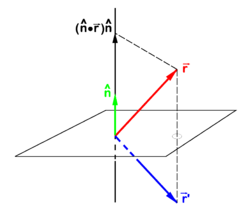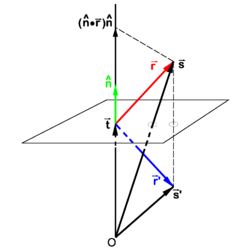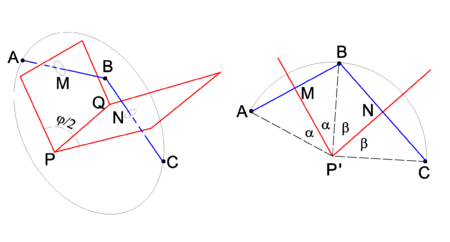Reflection (geometry): Difference between revisions
imported>Paul Wormer No edit summary |
imported>Paul Wormer No edit summary |
||
| Line 9: | Line 9: | ||
\sigma^\mathrm{T} = \sigma^{-1} = \sigma. \, | \sigma^\mathrm{T} = \sigma^{-1} = \sigma. \, | ||
</math> | </math> | ||
Hence reflection is orthogonal and [[symmetric]]. Further it has [[determinant]] −1. Because σ is symmetric it has real | Hence reflection is orthogonal and [[symmetric]]: σ<sup>T</sup> = σ. Further it has [[determinant]] −1. Because σ is symmetric it has real [[eigenvalue]]s; since it is orthogonal its eigenvalues have modulus 1. In other words its eigenvalues are ±1. The product of the eigenvalues being the determinant (−1), the eigenvalues of σ are either {1, 1, −1}, or {−1, −1, −1}. An operator with the latter set of eigenvalues is minus the identity operator, this operator is known alternatively as inversion, reflection in a point, or parity operator. An operator with the former set of eigenvalues is reflection in a plane. Reflection in a plane will be considered further in this article. | ||
{{Image|Reflection in plane.png|right|250px|Fig. 1. The vector <math>\scriptstyle \vec{\mathbf{r}}</math> goes to <math>\scriptstyle\vec{\mathbf{r}}'</math> under reflection in a plane. The unit vector <math>\scriptstyle\hat{\mathbf{n}}</math> is normal to mirror plane. }} | {{Image|Reflection in plane.png|right|250px|Fig. 1. The vector <math>\scriptstyle \vec{\mathbf{r}}</math> goes to <math>\scriptstyle\vec{\mathbf{r}}'</math> under reflection in a plane. The unit vector <math>\scriptstyle\hat{\mathbf{n}}</math> is normal to mirror plane. }} | ||
| Line 28: | Line 28: | ||
\vec{\mathbf{r}}\,' = \vec{\mathbf{r}} - 2 \frac{ (\vec{\mathbf{n}}\cdot\vec{\mathbf{r}})\vec{\mathbf{n}}}{n^2} | \vec{\mathbf{r}}\,' = \vec{\mathbf{r}} - 2 \frac{ (\vec{\mathbf{n}}\cdot\vec{\mathbf{r}})\vec{\mathbf{n}}}{n^2} | ||
</math> | </math> | ||
Sometimes it is convenient to write this as a matrix equation. Introducing the [[dyadic product]], we obtain | |||
:<math> | |||
\vec{\mathbf{r}}\,' = \left[ \mathbf{E} - \frac{2}{n^2} \vec{\mathbf{n}} \otimes\vec{\mathbf{n}} \right] \; \vec{\mathbf{r}}, | |||
</math> | |||
where '''E''' is the 3×3 [[identity matrix]]. | |||
Dyadic products satisfy the matrix multiplication rule | |||
:<math> | |||
[\vec{\mathbf{a}}\otimes\vec{\mathbf{b}}]\, [ \vec{\mathbf{c}}\otimes\vec{\mathbf{d}}] = | |||
(\vec{\mathbf{b}} \cdot \vec{\mathbf{c}}) \big( \vec{\mathbf{a}}\otimes\vec{\mathbf{d}} \big). | |||
</math> | |||
By the use of this rule it is easily shown that | |||
:<math> | |||
\left[ \mathbf{E} - \frac{2}{n^2} \vec{\mathbf{n}} \otimes\vec{\mathbf{n}} \right]^2 | |||
= \mathbf{E}, | |||
</math> | |||
which confirms that reflection is involutory. | |||
<!-- | |||
This relation can be immediately generalized to ''m''-dimensional inner product spaces. Let the space ''V''<sub>''m''</sub> allow an orthogonal direct sum decomposition into a 1-dimensional and a (''m''−1)-dimensional subspace, | This relation can be immediately generalized to ''m''-dimensional inner product spaces. Let the space ''V''<sub>''m''</sub> allow an orthogonal direct sum decomposition into a 1-dimensional and a (''m''−1)-dimensional subspace, | ||
:<math> | :<math> | ||
| Line 37: | Line 56: | ||
</math> | </math> | ||
is a reflection of ''r'' in the ''hyperplane'' ''V''<sub>''m−1''</sub>. (By definition a hyperplane is an ''m−1''-dimensional linear subspace of a linear space of dimension ''m''.) The inner product of two vectors ''v'' and ''w'' is notated as (''v'', ''w''), which is common for vector spaces of arbitrary dimension. | is a reflection of ''r'' in the ''hyperplane'' ''V''<sub>''m−1''</sub>. (By definition a hyperplane is an ''m−1''-dimensional linear subspace of a linear space of dimension ''m''.) The inner product of two vectors ''v'' and ''w'' is notated as (''v'', ''w''), which is common for vector spaces of arbitrary dimension. | ||
--> | |||
{{Image|Reflection shifted plane.png|left|250px|Fig. 2. The vector <math>\vec{\mathbf{s}}</math> goes to <math>\vec{\mathbf{s}}\,'</math> under reflection}} | {{Image|Reflection shifted plane.png|left|250px|Fig. 2. The vector <math>\vec{\mathbf{s}}</math> goes to <math>\vec{\mathbf{s}}\,'</math> under reflection}} | ||
==Reflection in plane not through origin== | ==Reflection in a plane not through the origin== | ||
In Figure 2 a plane, not containing the origin O, is considered that is orthogonal to the vector <math>\vec{\mathbf{t}}</math>. The length of this vector is the distance from O to the plane. | In Figure 2 a plane, not containing the origin O, is considered that is orthogonal to the vector <math>\vec{\mathbf{t}}</math>. The length of this vector is the distance from O to the plane. | ||
| Line 58: | Line 77: | ||
- 2 \big(\hat{\mathbf{n}}\cdot (\vec{\mathbf{s}} - \vec{\mathbf{t}})\big)\hat{\mathbf{n}}, | - 2 \big(\hat{\mathbf{n}}\cdot (\vec{\mathbf{s}} - \vec{\mathbf{t}})\big)\hat{\mathbf{n}}, | ||
</math> | </math> | ||
where <math>\hat{\mathbf{n}}</math> is a unit normal to the plane. Obviously <math>\vec{\mathbf{t}}</math> and <math>\hat{\mathbf{n}}</math> are proportional, differ by | where <math>\hat{\mathbf{n}}</math> is a unit normal to the plane. Obviously <math>\vec{\mathbf{t}}</math> and <math>\hat{\mathbf{n}}</math> are proportional, they differ only by scaling. Therefore, the equation can be written solely in terms of <math>\vec{\mathbf{t}}</math>, | ||
:<math> | |||
\vec{\mathbf{s}}\,' = \vec{\mathbf{s}} | |||
- 2 \frac{\vec{\mathbf{t}}\cdot (\vec{\mathbf{s}} - \vec{\mathbf{t}})}{t^2}\vec{\mathbf{t}}, \quad | |||
t^2 \equiv \vec{\mathbf{t}}\cdot \vec{\mathbf{t}}. | |||
</math> | |||
==Two consecutive reflections== | ==Two consecutive reflections== | ||
| Line 66: | Line 89: | ||
The drawing on the left shows that reflection of point A in the plane through PMQ brings the point A to B. A consecutive reflection in the plane through PNQ brings B to the final position C. In the right-hand drawing it is shown that the rotation angle φ is equal to twice the angle between the mirror planes. Indeed, the angle ∠ AP'M = ∠ MP'B = α and ∠ BP'N = ∠ NP'C = β. The rotation angle ∠ AP'C ≡ φ = 2α + 2β and the angle between the planes is α+β = φ/2. | The drawing on the left shows that reflection of point A in the plane through PMQ brings the point A to B. A consecutive reflection in the plane through PNQ brings B to the final position C. In the right-hand drawing it is shown that the rotation angle φ is equal to twice the angle between the mirror planes. Indeed, the angle ∠ AP'M = ∠ MP'B = α and ∠ BP'N = ∠ NP'C = β. The rotation angle ∠ AP'C ≡ φ = 2α + 2β and the angle between the planes is α+β = φ/2. | ||
It is obvious that the product of two reflections is a rotation. Indeed, a reflection is [[orthogonal]] and has [[determinant]] −1. The product of two orthogonal operators is again orthogonal and the rule for determinants is det(''AB'') = det(''A'')det(''B''), so that the product of two reflections is an orthogonal operator with unit determinant, i.e., a rotation. | |||
Let the normal of the first plane be <math>\vec{\mathbf{s}}</math> and of the second <math>\vec{\mathbf{t}}</math>, then the rotation is represented by the matrix | |||
:<math> | |||
\left[ \mathbf{E} - \frac{2}{t^2} \vec{\mathbf{t}} \otimes\vec{\mathbf{t}} \right]\, \left[ \mathbf{E} - \frac{2}{s^2} \vec{\mathbf{s}} \otimes\vec{\mathbf{s}} \right] | |||
= \mathbf{E} - \frac{2}{t^2} \vec{\mathbf{t}} \otimes\vec{\mathbf{t}} - \frac{2}{s^2} \vec{\mathbf{s}} \otimes\vec{\mathbf{s}} + \frac{4}{t^2 s^2} (\vec{\mathbf{t}}\cdot\vec{\mathbf{s}})\; | |||
\big(\vec{\mathbf{t}} \otimes\vec{\mathbf{s}}\big) | |||
</math> | |||
The ''(i,j)'' element if this matrix is equal to | |||
:<math> | |||
\delta_{ij} - \frac{2 t_i t_j }{t^2} - \frac{2 s_i s_j }{s^2} + \frac{4 t_i s_j (\sum_k t_k s_k)}{t^2 s^2} | |||
</math> | |||
Revision as of 02:24, 20 July 2009
In analytic geometry, a reflection is a linear operation σ on with σ2 = 1, i.e., σ is an involution, and σ−1 = σ. Reflecting twice an arbitrary vector brings back the original vector :
The operation σ is orthogonal, i.e., preserves inner products, so that
Hence reflection is orthogonal and symmetric: σT = σ. Further it has determinant −1. Because σ is symmetric it has real eigenvalues; since it is orthogonal its eigenvalues have modulus 1. In other words its eigenvalues are ±1. The product of the eigenvalues being the determinant (−1), the eigenvalues of σ are either {1, 1, −1}, or {−1, −1, −1}. An operator with the latter set of eigenvalues is minus the identity operator, this operator is known alternatively as inversion, reflection in a point, or parity operator. An operator with the former set of eigenvalues is reflection in a plane. Reflection in a plane will be considered further in this article.
Reflection in a plane
If is a unit vector normal (perpendicular) to a plane—the mirror plane—then is the projection of on this unit vector. From the figure it is evident that
If a non-unit normal is used then substitution of
gives the mirror image,
Sometimes it is convenient to write this as a matrix equation. Introducing the dyadic product, we obtain
where E is the 3×3 identity matrix.
Dyadic products satisfy the matrix multiplication rule
By the use of this rule it is easily shown that
which confirms that reflection is involutory.
Reflection in a plane not through the origin
In Figure 2 a plane, not containing the origin O, is considered that is orthogonal to the vector . The length of this vector is the distance from O to the plane. From Figure 2, we find
Use of the equation derived earlier gives
And hence the equation for the reflected pair of vectors is,
where is a unit normal to the plane. Obviously and are proportional, they differ only by scaling. Therefore, the equation can be written solely in terms of ,
Two consecutive reflections
Two consecutive reflections in two intersecting planes give a rotation around the line of intersection. This is shown in Figure 2, where PQ is the line of intersection. The drawing on the left shows that reflection of point A in the plane through PMQ brings the point A to B. A consecutive reflection in the plane through PNQ brings B to the final position C. In the right-hand drawing it is shown that the rotation angle φ is equal to twice the angle between the mirror planes. Indeed, the angle ∠ AP'M = ∠ MP'B = α and ∠ BP'N = ∠ NP'C = β. The rotation angle ∠ AP'C ≡ φ = 2α + 2β and the angle between the planes is α+β = φ/2.
It is obvious that the product of two reflections is a rotation. Indeed, a reflection is orthogonal and has determinant −1. The product of two orthogonal operators is again orthogonal and the rule for determinants is det(AB) = det(A)det(B), so that the product of two reflections is an orthogonal operator with unit determinant, i.e., a rotation.
Let the normal of the first plane be and of the second , then the rotation is represented by the matrix
The (i,j) element if this matrix is equal to














![{\displaystyle {\vec {\mathbf {r} }}\,'=\left[\mathbf {E} -{\frac {2}{n^{2}}}{\vec {\mathbf {n} }}\otimes {\vec {\mathbf {n} }}\right]\;{\vec {\mathbf {r} }},}](https://wikimedia.org/api/rest_v1/media/math/render/svg/cb112d732fbaf7c81a05f819922f6b4d713dc646)
![{\displaystyle [{\vec {\mathbf {a} }}\otimes {\vec {\mathbf {b} }}]\,[{\vec {\mathbf {c} }}\otimes {\vec {\mathbf {d} }}]=({\vec {\mathbf {b} }}\cdot {\vec {\mathbf {c} }}){\big (}{\vec {\mathbf {a} }}\otimes {\vec {\mathbf {d} }}{\big )}.}](https://wikimedia.org/api/rest_v1/media/math/render/svg/037a6b38897a0d8a8d7787a0ea60a4e18d091281)
![{\displaystyle \left[\mathbf {E} -{\frac {2}{n^{2}}}{\vec {\mathbf {n} }}\otimes {\vec {\mathbf {n} }}\right]^{2}=\mathbf {E} ,}](https://wikimedia.org/api/rest_v1/media/math/render/svg/cd65ff7a8f5970ebba0e77e1a5680c6192a28266)









![{\displaystyle \left[\mathbf {E} -{\frac {2}{t^{2}}}{\vec {\mathbf {t} }}\otimes {\vec {\mathbf {t} }}\right]\,\left[\mathbf {E} -{\frac {2}{s^{2}}}{\vec {\mathbf {s} }}\otimes {\vec {\mathbf {s} }}\right]=\mathbf {E} -{\frac {2}{t^{2}}}{\vec {\mathbf {t} }}\otimes {\vec {\mathbf {t} }}-{\frac {2}{s^{2}}}{\vec {\mathbf {s} }}\otimes {\vec {\mathbf {s} }}+{\frac {4}{t^{2}s^{2}}}({\vec {\mathbf {t} }}\cdot {\vec {\mathbf {s} }})\;{\big (}{\vec {\mathbf {t} }}\otimes {\vec {\mathbf {s} }}{\big )}}](https://wikimedia.org/api/rest_v1/media/math/render/svg/454d07547f582382357684b9dc6463f3ff0ecbbc)
